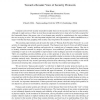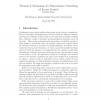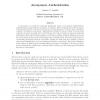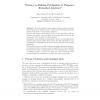SPW
2004
Springer
13 years 10 months ago
2004
Springer
This note presents a new way of composing cryptographic primitives which makes some novel combinations possible. For example, one can do threshold decryption using standard block c...
SPW
2004
Springer
13 years 10 months ago
2004
Springer
SPW
2004
Springer
13 years 10 months ago
2004
Springer
SPW
2004
Springer
13 years 10 months ago
2004
Springer
SPW
2004
Springer
13 years 10 months ago
2004
Springer
In this paper, we present a security framework that provides identity protection against active and passive attacks for end-points. The framework is based on a two-round-trip authe...
SPW
2004
Springer
13 years 10 months ago
2004
Springer
Abstract Fabio Massacci1 and Nicola Zannone1 Department of Information and Communication Technology University of Trento - Italy {massacci,zannone} at dit.unitn.it The last years h...
SPW
2004
Springer
13 years 10 months ago
2004
Springer
Hardly a day passes without reports of new threats in or about the Internet. Denial of service, worms, viruses, spam, and divulged credit card information highlight the major secu...
SPW
2004
Springer
13 years 10 months ago
2004
Springer
This position paper discusses the relation of privacy, namely pseudonymity, to evidence-based trust (or rather reputation). Critical concepts of evidence-based trust/reputation sys...
SPW
2004
Springer
13 years 10 months ago
2004
Springer
SPW
2004
Springer
13 years 10 months ago
2004
Springer
This paper identifies certain privacy threats that apply to anonymous credential systems. The focus is on timing attacks that apply even if the system is cryptographically secure....





